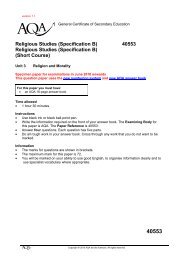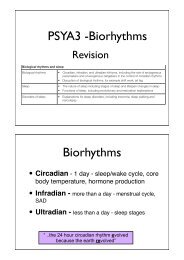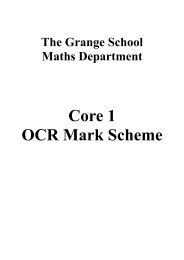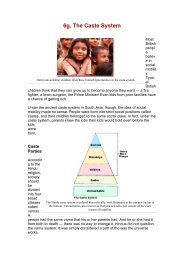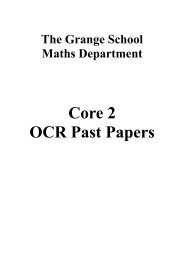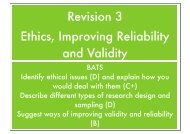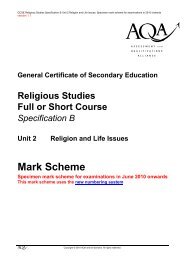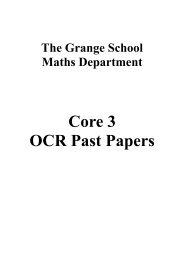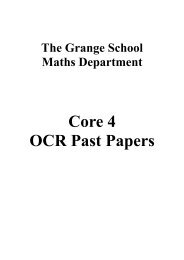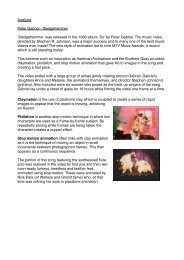core study Haber and Levin - The Grange School Blogs
core study Haber and Levin - The Grange School Blogs
core study Haber and Levin - The Grange School Blogs
You also want an ePaper? Increase the reach of your titles
YUMPU automatically turns print PDFs into web optimized ePapers that Google loves.
CORE STUDY- HABER<br />
AND LEVIN (2001)<br />
BATs<br />
Describe (D) <strong>and</strong> evaluate(B) <strong>Haber</strong> <strong>and</strong> <strong>Levin</strong>’s<br />
research into the role of familiarity in depth perception.<br />
Debate which theory of perception is most likely (B+)
KEY WORD BINGO<br />
constancy<br />
bottom-up processing<br />
perceptual set<br />
nature<br />
optic flow<br />
top-down processing<br />
ambiguous illusion<br />
Find out what these<br />
words mean p93-99<br />
choose 4 of these words<br />
illusion<br />
linear perspective<br />
superimposition<br />
texture gradient<br />
perception<br />
sensation<br />
geometric illusion
Constructivist vs Nativist<br />
theory of perception<br />
Perception develops through<br />
experience.<br />
Perception relies on top-down<br />
processing.<br />
Perception is an instinctive<br />
process which is innate.<br />
Perception relies on bottomup<br />
processing.<br />
Perceptual set is key in<br />
perception – we perceive based<br />
on what has come before, e.g.<br />
expectations, motivation.<br />
All the information that we need<br />
to perceive is already in the<br />
optic array.<br />
Perception varies from culture to<br />
culture.<br />
Perception is universal – we<br />
all perceive the world in more<br />
or less the same way.
HABER & LEVIN (2001):<br />
CORE STUDY<br />
Method:<br />
experiment.<br />
Design: Repeated measures<br />
Aim - To investigate if topdown<br />
or bottom-up processing is<br />
a better way of explaining<br />
Perception<br />
Sample:<br />
nine male college students with good eyesight.<br />
Setting:<br />
large grassy field divided into four quadrants.
EACH QUADRANT CONTAINED<br />
SOMETHING DIFFERENT…<br />
Real world objects with a known<br />
<strong>The</strong> arrival area which was empty.<br />
Size, e.g. milk bottle, door.<br />
objects from the centre of the field<br />
Real world objects which could be<br />
Cardboard cut outs of geometric<br />
different sizes, e.g. Christmas tree,<br />
teddy.<br />
<strong>The</strong> participants viewed<br />
In which quadrant<br />
did they judge the size<br />
of the objects best <strong>and</strong><br />
why?<br />
shapes.<br />
Participants<br />
judged the size of the<br />
objects most accurately<br />
because they were<br />
familiar
OVER TO YOU...<br />
Make a 3D model to illustrate a re-creation of this<br />
experiment<br />
Fill in the summary sheet or create a storyboard or flow<br />
chart to help you remember the procedure <strong>and</strong> results of this<br />
experiment
CAN WE SHARE?<br />
Judge who has made the best model <strong>and</strong> say why!<br />
What limitations does this<br />
<strong>study</strong> have - discuss in pairs
LIMITATIONS OF THE STUDY<br />
Why is it difficult to draw conclusions from the sample?<br />
It was only made up of nine participants <strong>and</strong> they were all male students.<br />
Why was the setting artificial?<br />
It was set in a field <strong>and</strong> the task involved judging r<strong>and</strong>omly placed items.<br />
Why can we not be sure that familiar items were actually ‘familiar’?<br />
<strong>The</strong> researchers only had the participants’ word for it <strong>and</strong> familiarity is<br />
subjective anyway.
ESSAY PREP!!<br />
- How<br />
does this research support<br />
Constructivist theory?
NATURE OR<br />
NURTURE?<br />
Plenary –<br />
Nature v nurture debate - fill in a<br />
scales sheet<br />
go to diff ends of room according to<br />
view - be prepared to justify your<br />
reason for st<strong>and</strong>ing there!
HOMEWORK<br />
Describe the Constructivist<br />
theory (4 marks) <strong>and</strong> use research e.g.<br />
<strong>Haber</strong> <strong>and</strong> <strong>Levin</strong>’s expt to support or<br />
challenge these theories (4 marks). Finish<br />
with a paragraph to decide if it is Nature,<br />
Nurture or both that play a role in<br />
Perception (2 marks) - justify!<br />
“Describe Research into the<br />
Role of Nature <strong>and</strong> Nurture<br />
in Perception” (10 marks)<br />
ask SJ for a simpler option if<br />
this seems too hard!
Homework<br />
• “Describe Research into the<br />
Role of Nature <strong>and</strong> Nurture in<br />
Perception” (12 marks)<br />
Describe the Constructivist theory (4 marks)<br />
Use research e.g. <strong>Haber</strong> <strong>and</strong> <strong>Levin</strong>’s expt to support <strong>and</strong> the<br />
Nativist theory to challenge the Constructivist theory (6<br />
marks).<br />
Finish with a paragraph to decide if it is Nature, Nurture or<br />
both that play a role in Perception (2 marks) - don’t forget to<br />
justify your decision!
Homework<br />
• “Describe <strong>and</strong> evaluate the<br />
Constructivist theory of Perception<br />
(6marks)<br />
Describe the Constructivist theory (4 marks)<br />
Write about 2 criticisms of theory or one in more depth (2<br />
marks)<br />
BONUS 4 marks<br />
Use research e.g. <strong>Haber</strong> <strong>and</strong> <strong>Levin</strong>’s expt to support <strong>and</strong> the<br />
Nativist theory to challenge the Constructivist theory.<br />
BONUS 2 marks<br />
Finish with a paragraph to decide if it is Nature, Nurture or<br />
both that play a role in Perception (2 marks) - don’t forget to<br />
justify your decision!



